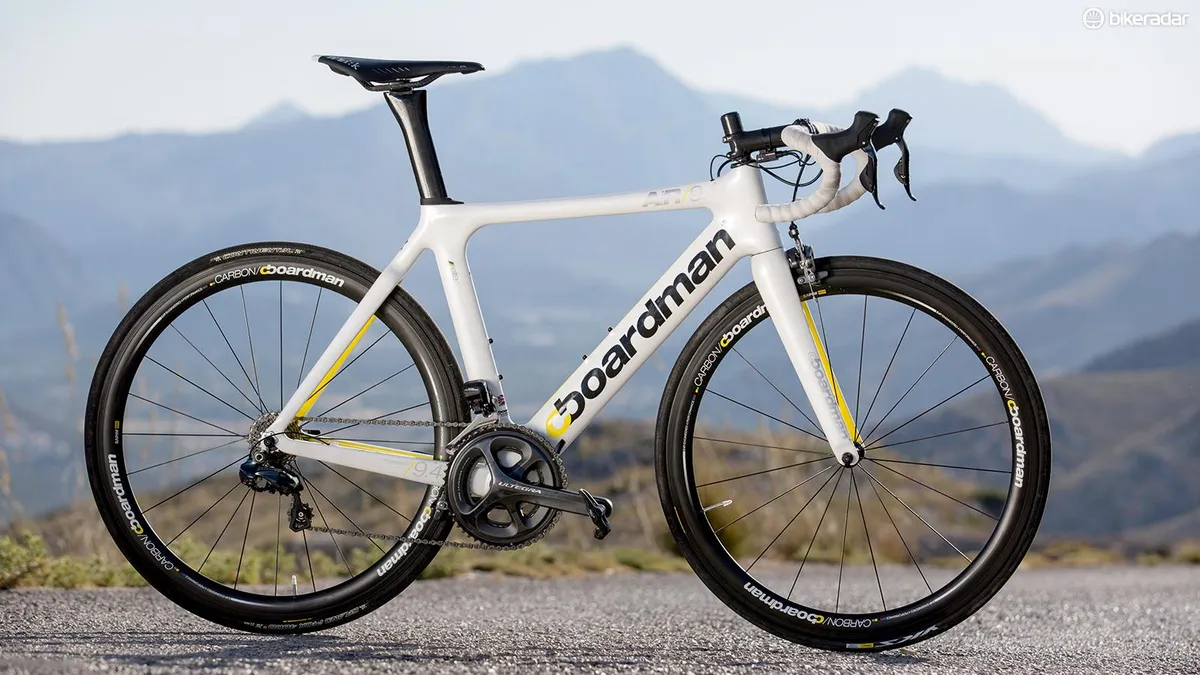Boardman’s AiR aero road bikes have been dominating the world of triathlon under the Brownlee brothers for a while, but they’re equally applicable to a broad range of fast, efficient, minimum fatigue road use too.
- Highs: Clean aero efficiency with very user friendly handling and ride quality
- Lows: Poor rear brake feel and hefty despite carbon wheels
- Buy if: You want a very coherent, easily enjoyable aero all-rounder
You’re getting the same AiR frame right through the range, from Dura-Ace 9.8 spec down to 105 9.,0 rather than the 'same mould, lower grade' price point specific carbon lay ups used to reduce costs on a lot of ranges. It’s as smoothly sculpted and aero efficient as you’d expect from the lifelong anti-drag devotion of Britain’s original hour record hero.
The slim elliptical tube profiles are designed to slide through the air as cleanly as possible rather than deliberately creating turbulence from blunt ‘Kammtail’ trailing edges seen on some other aero bikes. There are no wheel-hugger cutouts either, but the wishbone rear stay and fork leg ‘wing’ cross section is designed to pull air away from the rotating spokes to reduce drag in this turbulence black spot.
A flush fit seat clamp for the aero seatpost and internal cable routing that top loads behind the stem also keeps airflow clean. The 9.4 gets a conventional front of fork brake rather than a V brake hidden inside the crown like the 9.8 and AiR TT bikes. The rear brake hides under the big tapering rectangular stays though.
Shimano Ultegra Di2 needs no introduction but function proved as flawless as ever with a close ratio 11-25t cassette for smooth cadence but 50/34t compact chainring for realistic climbing.

Even after serious hours in the saddle, the Boardman remained a comfortable place to be
A four-setting saddle clamp seatpost allows conventional or thrust-forward seat positions if you’re using short extensions for triathlon. While the super compact Boardman bar felt awkward at first we really warmed to it during testing and the carbon stem is stiff too. The tape looks and feels cheap though.
The Boardman carbon wheels save around 200g over the alloy wheels on the BMC and Cervélo bikes we tested simultaneously, but don’t brake as predictably, particuarly in the wet. The rear brake was noticeably stiffer and less touchy feely to use than a conventional brake.
While bar and brakes might have take some getting used to at first, the overall fit and feel of the bike is as glovelike and balanced as you could want off the peg. The oversized bottom bracket area and chainstays are cast in one piece, which underpins the rock solid power delivery to the wheel.
The carbon wheels also boost acceleration and the Boardman loves charging out of corners or attacking climbs. Once you’re up to speed it sustains it with a quietly efficient determination, very little turbulence noise and a definite sense of tailwind compared with a conventional bike, particularly at higher speeds as you’d expect.
There’s no unsettling trace of the aero frame or wheel profiling in the handling though with the AiR being both obedient at slow speeds out of the saddle and stable enough to get right over onto the edges of the Continental rubber down Majorca's Sa Calobra or drop at 60mph plus towards Hawes in the Yorkshire Dales.
The GP4000S II Contis help corner-hooking confidence too, although allowances definitely have to be made for the brakes in the wet.
While there’s enough precision to make all risks accurately calculated, the tapered head tube and relatively tall frame tubes never feel punishing. Even after 330km and 12hrs in the saddle around Majorca hands and feet still felt fresh and shoulders and shorts were a lot more comfortable than expected.
There’s plenty of room for 25c tyres if you want a bit more float too, making this a very versatile, naturally high velocity all rounder at a really keen price.



